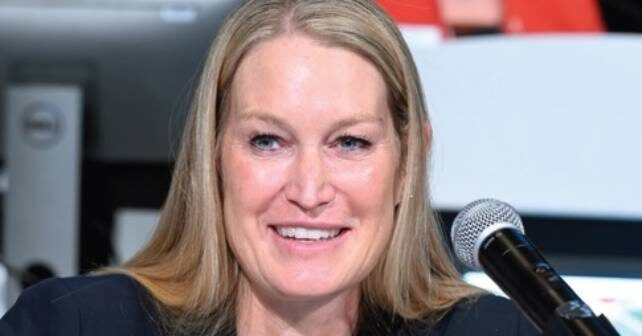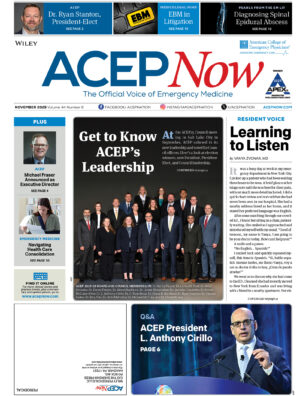
Speaking with Dr. Gillian Schmitz as she continues her tireless work at the College, we reviewed hot topics like violence in the emergency department (ED), mental health, and the future of the profession.
Explore This Issue
ACEP Now: Vol 41 – No 07 – July 2022Question: The emergency department should be a safe place for everyone, but just recently we have seen orthopedic physicians and staff murdered and emergency workers stabbed. What has ACEP done to address workplace safety?
Dr. Schmitz: ACEP has made addressing violence in the ED a top advocacy priority. ACEP initiated the “No Silence on ED Violence” campaign with the Emergency Nurses Association (ENA) in 2019. This joint effort equips and empowers our respective members to effect needed safety improvements at their hospitals, while engaging state and federal policymakers, stakeholder organizations, and the public at large to generate action to address this crisis. In 2020, ACEP and ENA were part of an action team sponsored by the National Quality Forum, which included 27 experts and recognized leaders from the private and public sector committed to improving the safety of the health care workforce. Throughout the pandemic, we all felt a rise in the hostility of our patients and the public and increased emotional and physical violence in the ED. ACEP surveyed our membership and found some startling statistics. Almost half of emergency physicians report being physically assaulted at work, while about 70 percent of emergency nurses report being hit and kicked while on the job.
Getting kicked, punched, or emotionally assaulted at work should never be “part of the job.” Assailants who threaten health care workers need to be held accountable. Physicians and nurses need to feel safe. ACEP felt so strongly about this issue that we made it one of our three major advocacy focuses at our Leadership and Advocacy Conference (LAC) in 2022. We hosted hundreds of meetings with legislators to support the Workplace Violence Prevention Act for Health Care and Social Service Workers (H.R. 1195) and its companion bill in the Senate. This bill would require OSHA to create standards to curb ED violence and track and report cases of assault. ACEP also contributed to the development of new The Joint Commission (TJC) workplace violence prevention requirements that became effective at the beginning of this year.
Question: The COVID-19 pandemic has taken a toll on emergency physicians. ACEP recently celebrated the success of the Dr. Lorna Breen Act. Last year, when we spoke to ACEP Immediate Past President Rosenberg, govtrack.us gave the bill a three percent chance of ever passing. How did ACEP succeed where the experts thought we would fail?
Dr. Schmitz: Isn’t that the very essence of emergency medicine—that we succeed when everyone else thinks we’re going to fail? I love to keep proving them wrong. Advocacy is what ACEP does best. Most people don’t understand that 99.9 percent of bills never become a law; they rarely even get out of committee. I want to particularly highlight the work of Brad Gruehn, Laura Wooster, Ryan McBride, and Jeff Davis, who fought relentlessly to help pass the bipartisan legislation that is the Lorna Breen Act.
I also want to recognize the grassroots efforts of emergency physicians nationwide, the ACEP members who specifically met with their legislators during our LAC conference to garner support, Senator Tim Kaine (D-VA) who helped introduce the bill, and of course Lorna’s family and the Lorna Breen Heroes Foundation that helped this come to fruition. ACEP continues working on both the legislative and regulatory front at the federal and state level to address some of the remaining challenges and barriers to mental health for health care workers and our patients. This is really just the beginning.
Question: This year‘s Match was concerning due to hundreds of empty residency spots. Anecdotally, people have said this might be due to ACEP’s workforce projections or due to the explosion of EM residency programs in recent years. What‘s your take on why so many EM programs went unfilled?
Dr. Schmitz: I believe the results of this year’s Match were a good wake-up call and an opportunity to do things differently. The reasons so many EM programs went unfilled is multifactorial. First and foremost, it was not because we had a drop-off in applicants. Emergency medicine continues to be one of the most competitive specialties in medicine and we would like it to stay that way. The number of applicants in 2022 was roughly on par with where we have been over the past five years. We had more students apply this year than we did in 2019. We did see a drop from last year, but that’s only because 2021 was an anomaly and we saw a record number of applicants during the beginning and peak of the pandemic. If you take out the 2020–2021 match season as an outlier, the number of applicants were exactly what we expected.
I believe the match went initially unfilled for a number of other reasons. First, there were more residency spots as a few new EM programs were approved and some existing programs expanded their class size. Financial pressures will incentivize residency programs to grow. We need to start having some difficult conversations on how we control that growth in a responsible manner and put the needs of the specialty ahead of an individual residency program’s best interests. Second, we had another year of virtual rotations and interviews. One of the main reasons applicants cite when creating their rank list is perceived overall “fit” with the program. It is hard to replicate those personal experiences over webcam and the virtual recruitment season likely swayed the match results. Finally, there are probably some residency programs who miscalculated their overall competitiveness amongst applicants. If a program only submitted 50 names (when they should have submitted 100+), they are likely not going to fill all of their spots. It is possible that many of the applicants ranked all the same programs and that impacted the match.
To help better match interest with demand, CORD has discussed piloting a “preference signaling” system next year. This would allow students to indicate early on if a program is one of their top five choices and would allow residencies to better predict which applicants they are likely to recruit. This method worked really well for ENT, and I’m excited to see how this may help us better align student interest with available slots in the future.
Question: We hope you have you been reading ACEP Now. What is your favorite story from this past year?
Dr. Schmitz: My favorite was the story on Ukraine. It is empowering to see that even in our darkest moments, emergency physicians rally together to protect, serve, and care for our patients and for each other. It highlighted to me that while others may run away from danger and the unknown, emergency physicians run to it and do whatever is needed in the moment. It restored my faith in humanity and is a constant reminder that what we do has purpose.
Dr. Dark (@RealCedricDark) is assistant professor of emergency medicine at Baylor College of Medicine and the medical editor in chief of ACEP Now.
Pages: 1 2 3 | Multi-Page







No Responses to “A Mid-Year ACEP Overview with President Dr. Gillian Schmitz”